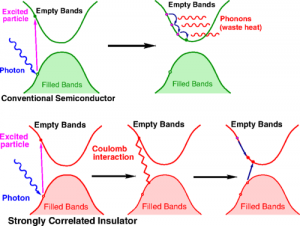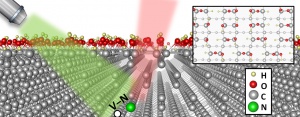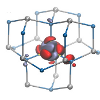Template:Highlights
In collaboration with German (Jörg Wrachtrup group at Stuttgart University) and Swedish (Erik Janzén group at Linköping University) researchers, we report the characterization of photoluminescence and optical spin polarization from single silicon vacancies in SiC, and demonstrate that single spins can be addressed at room temperature. We show coherent control of a single defect spin and find long spin coherence times under ambient conditions. Our study provides evidence that SiC is a promising system for atomic-scale spintronics and quantum technology. Our study is highlighted in a News and Views article from Nature Materials.
Nature Materials AOP (2014). DOI:10.1038/nmat4145
Together with colleagues in the United States, we have investigated and proposed a new kind of material for photovoltaics. In strongly correlated insulators, strong Coulomb interactions make highly photoexcited electron-hole pairs decay fast into multiple electron-hole pairs via impact ionization, thus preventing slower energy dissipation to heat by phonons. The prototypical M1-type vanadium-oxide insulator have been used for computational simulations, which may be a first example of a new class of photovoltaic materials.
Phys. Rev. B 90, 165142 (2014). DOI:10.1103/PhysRevB.90.165142
In collaboration with Bremen Center for Computational Materials Science we have identified such a diamond surface that would be ideal to host shallow implanted nitrogen-vacancy centers in diamond for sensing at the nanoscale.
Nano Letters 14 4772-4777 (2014). DOI:10.1021/nl501927y
The electron spins of semiconductor defects can have complex interactions with their host, particularly in polar materials like SiC where electrical and mechanical variables are intertwined. By combining pulsed spin resonance (David Awschalom group at Chicago University) with ab initio simulations, we show that spin-spin interactions in 4H−SiC neutral divacancies give rise to spin states with a strong Stark effect, sub-10−6 strain sensitivity, and highly spin-dependent photoluminescence with intensity contrasts of 15%–36%. These results establish SiC color centers as compelling systems for sensing nanoscale electric and strain fields.
Physical Review Letters 112 187601 (2014). DOI:10.1103/PhysRevLett.112.187601
In the field of methodology development, we have constructed a DFT scheme combining hybrid exchange and DFT+U strategies. This machinery seems to be an efficient tool in DFT calculations involving solid-state defects with highly localized electronic orbitals, as its tests on two typical systems show.
Physical Review B 90 035146 (2014) DOI:10.1103/PhysRevB.90.035146
Our group members at Wigner ADMIL laboratory have succeeded manufacturing carbon antisite–vacancy colour centres in silcon carbide nanoparticles. These colour centres behave as single-photon emitters, and therefore may be used in the future in nanometrology and quantum informatics. The biocompatibiliy of SiC makes these defects ideal candidates for biosensing at the molecular level.
ACS Nano 8 7938-7947 (2014). DOI:10.1021/nn502719y




